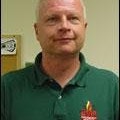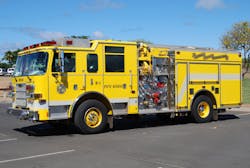In the last installment of our “Innovative Rigs on the Street” column we visited the island of Maui and the Maui County Department of Fire and Safety. The department operates with 14 engine companies, two ladder companies and a host of specialized units including a rescue company, hazardous materials unit, tankers and several mini pumpers.
The department protects all areas on the islands of Maui, Molokai and Lanai and is under the command of Chief Jeffery A. Murray. During our stay on the islands we were afforded the opportunity to visit a number of stations that operate apparatus specifically designed to handle the hazards within their response areas.
The Department
The 10 fire stations located on the island of Maui are strategically located in the different population centers where tourism is one of the predominant economic industries. Providing fire protection over the 727-square-mile area presents a challenge with elevations ranging from sea level to over 10,000 feet, over 120 miles of shoreline and narrow roadways in many areas. As a good portion of the island is within five miles of the coastline there is a strong marine influence, which impacts wildland firefighting tactics. For these reasons the department has adopted a progressive attitude towards apparatus design where units must be capable of operating independently for long periods of time.
Station 1: Northern Coast
Fire Station 1 is located in Wailuku on the northern coast of the island. This area is one of the older areas and is developed with stores, shopping areas and is home to the Maui Medical Center and the Maui Arts and Cultural Center. Station 1’s first due area includes a large area of the coastline along the Kahekili Highway that has many narrow points and switchbacks, which makes the use of full-size apparatus almost impossible. For these reasons the station operates with both a mini pumper and one of two 2007 Pierce Arrow XT model pumpers.
Engine 1 is built on a 184.5-inch wheelbase with an overall length of 29 feet, 7 inches and is powered by a Detroit Diesel Series 60 engine rated at 515 horsepower. This engine is equipped with a 1,500 gpm pump, 750-gallon water tank together with a 50-gallon Class A foam tank. A Pierce Husky compressed air foam system with a 200-cfm compressor can supply a number of discharges on the apparatus. Four crosslay hosebeds are available with two rear hose body discharges for preconnected attack lines. In place of standard aluminum tread plate scuff panels both the front and rear sides of the aluminum body are covered with brushed stainless steel for reduced maintenance. The body is 140 inches long and is equipped with seven enclosed body compartments with a hydraulic ladder rack.
Mini 1 is a 2006 GMC 5500 four-wheel drive chassis with Pierce aluminum bodywork. This unit is equipped with a 500-gpm pump, 300-gallon water tank with a 10-gallon foam cell supplying a Hercules CAFS system. Mini 1 is outfitted with a front-mounted bumper turret, overhead ground ladder rack and an aluminum body with roll-up doors. These two pieces of apparatus provide an assortment of tactical options for use on the fireground and were designed to easily maneuver in the tight, restricted areas within their first due area.
Station 7: Eastern End of Island
At the eastern end of the island of Maui lies the community of Hana, which is some 45 miles distant from the next closest fire station. Hana is protected by Fire Station 7, which is equipped with three pieces of apparatus, including a 2007 Pierce Arrow XT pumper assigned as Engine 7. Mini 7 is a 2004 Ford F-550 four-wheel drive vehicle built by Pierce that carries a 500-gpm pump, 275-gallon water tank and a compressed air foam system. The newest unit is Tanker 7, a 2010 International 7600 two-door cab chassis with aluminum bodywork by Classic Fire Apparatus in cooperation with Emergency One. Tanker 7 carries 1,800 gallons of water together with a 500-gpm pump, 20-gallon Class A foam tank and front-bumper turret.
New Deliveries
During 2010, the department took delivery of two Emergency One Cyclone II pumpers and assigned them to Station 2 in Paia and Station 13 in Kula. These units are built with a 180-inch wheelbase with an overall length of 29 feet, 1 inch. The engines are equipped with a Waterous single-stage pump rated at 1,500 gpm with a 750-gallon water tank and a 30-gallon foam tank. In place of fixed side windows, exterior compartments were provided with roll-up doors. The aluminum bodies are equipped with seven enclosed compartments with storage space for a stokes basket and ground ladders at the rear of the apparatus. Aluminum tread plate hosebed covers are provided to protect the hose and equipment carried in this area.
The island of Molokai is protected by three fire stations 4, 9 and 12 located at Kaunakaki, Ho’olekua and Puko’o. Due to the remote location of these stations any mutual aid is coming from the island of Maui where additional personnel would be transported to Molokai using department leased helicopters. Molokai has some very rugged terrain with many structures located some distance from paved roadways. For this reason several stations are assigned rigs with four wheel drive capability.
Engine 9 operates with a 2005 Pierce Saber 4x4 pumper equipped with a 1,000-gpm pump, 750-gallon water tank, 30 gallons of Class A foam with a Husky foam system. The apparatus carries four preconnected attack lines in crosslay hosebeds in addition to a top-mounted deck gun and portable Task Force Blitz fire monitor. The aluminum body is provided with roll-up shutter doors and a hydraulic ladder rack. Engine 12 is assigned a 2003 Kenworth T-300 four-door cab chassis with bodywork by Pierce. This apparatus is equipped with a Darley LMP pump rated at 500 gpm with a 750-gallon water tank and a 30-gallon foam tank. Engine 12 maintains CAFS capability with a Darley foam system that can supply preconnected handlines together with a front-mounted bumper turret. The rescue style body compartments are stepped up in the rear to provide additional clearance during off-road operations and carry a left-side hydraulic ladder rack.
Geography & Climate Pose Design Challenges
As many of the departments fire stations were built back in earlier years, the design of the engine company units must take into consideration the restrictions of station bay space as well as the unique characteristics of the weather, topography and roads on the islands. For this reason the engine apparatus are designed with a minimal front-bumper extension to improve the angle of approach and reduce the overall length of the apparatus. The crosslay hosebeds on the Pierce units were designed low to the ground as the department utilizes shoulder loads for their preconnected attack lines.
Due to the high concentration of salt air, the use of aluminum tread plate was minimized where possible. In high wear areas such as the interior of cab doors, pump panel area and rear body panels were protected with brushed stainless steel. Engines are provided with remote-control deck guns to provide safer and more efficient use of personnel. This appliance, together with the use of Blitz Fire portable monitors and bumper-mounted turret monitors, provides multiple means for the engine apparatus to deploy their rated pump capacity using heavy-stream appliances.
While the Maui County Department of Fire and Public Safety may be considered small, with respect to the number of fire stations when compared to some departments back here on the mainland, the department can be justifiably proud of their commitment to providing excellent service to the community. Appreciation is extended to Deputy Chief Robert Shimada who assisted in making arrangements for fire station visits and apparatus photographs.
- See Tom Shand Live! Join Tom for a live recording of the Apparatus Architects at Firehouse World on Feb. 1. Tom Shand will be presenting "Fire Apparatus Purchasing: What You Need to Know Before Signing the Contract" on Feb. 28 and "Engine Company Operations: The Top 5 Things You Need to Accomplish at All Incidents" on March 1.
TOM SHAND is a 37-year veteran of the fire service having served with departments in Maryland, Pennsylvania and New York. He has worked in the fire apparatus industry since 1985, including 15 years with Saulsbury Fire Apparatus. He is a contributing editor to Fire Apparatus Journal and Firehouse Magazine and works with Mike Wilbur at Emergency Vehicle Response. He co-hosts the Apparatus Architects podcast with Wilbur, based on their column in Firehouse Magazine. View all of Tom's magazine and online articles and podcasts here.
About the Author

Tom Shand
TOM SHAND, who is a Firehouse contributing editor, is a 36-year veteran of the fire service. He works with Michael Wilbur at Emergency Vehicle Response, consulting on a variety of fire apparatus and fire department master-planning issues. Shand is a member of the Firehouse Hall of Fame.
